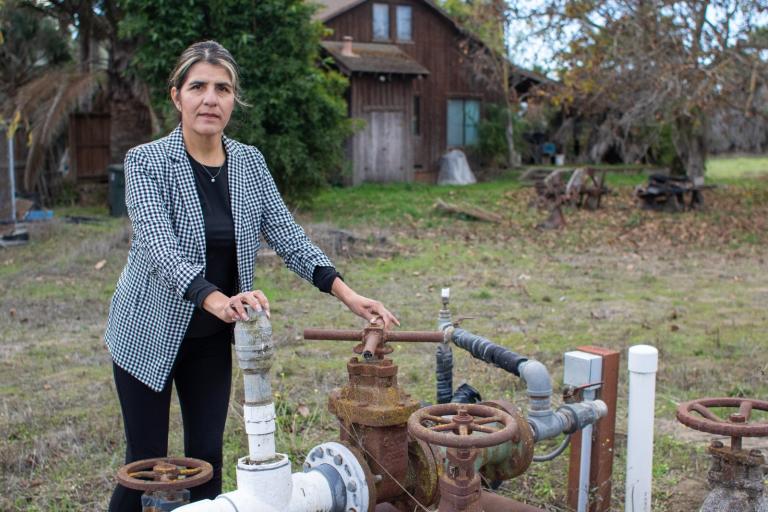
Photo by T.P. Martins.
When I examined the reasons agriculture often gets a pass in climate negotiations recently, I pointed to the fact that precise measurement of the climate impact of many industrial farming practices remains difficult and controversial. This is especially true when it comes to synthetic nitrogen fertilizer.
The effect of excess fertilizer on our waterways gets much more attention than it does when it enters the air. And for good reason. It’s toxic to consume nitrates in your drinking water. We’re learning that agricultural overuse of fertilizer has contaminated the drinking water of whole regions of California. Meanwhile, nitrogen that runs into the ocean causes oxygen-depleted “dead zones” around the world. The dead zone in our own Gulf Of Mexico (measured every summer) keeps getting larger — last year’s was the size of New Jersey.
While we know that excess fertilizer escapes farm fields as gas, exactly how much and where it goes has largely been a mystery. But it has been a mystery worth solving, as the amount of nitrous oxide — the third most potent greenhouse gas behind carbon dioxide and methane — in the atmosphere is increasing fast. In fact, it has risen by 20 percent since the Industrial Revolution, with a good part of that increase coming in the last 50 years. For the sake of comparison, atmospheric carbon dioxide rates have increased around 40 percent in the same period. But nitrous oxide is around 300 times more potent as a greenhouse gas. And it’s also a major ozone-depleting chemical.
Pinpointing the cause of these nitrous emissions has been made especially difficult by the fact that every molecule of nitrous oxide looks alike. And there are so many sources — from microbes in farm fields, oceans, and natural landscapes to oceanic phenomena and human activities like rainforest destruction.
As a result, it has been impossible to know just how much is coming from fertilizer use; and Big Ag has never been made accountable. But that may have all just changed.
Now, a group of scientists at the University of California, Berkeley have found a way to “fingerprint” various sources of nitrous oxide — and they’ve determined that the accelerated increase in atmospheric nitrous oxide in the last few decades has indeed been due to synthetic nitrogen fertilizer use.
The researchers accomplished this feat through a fascinating technique — using a natural “archive” of air frozen in Antarctic ice combined with an actual archive of air samples taken from a (stunningly beautiful) pollution tracking station in Tasmania, Australia.
In their analysis, published in the journal Nature Geoscience, the scientists found that microbes in heavily fertilized farm fields produce nitrous oxide heavy with a particular isotope (nitrogen-14, for those keeping score at home). Their analysis also showed differences in the samples between the two sites that suggest the ability to create a geographical emissions map. As lead scientist Kristie Boering explains:
The fact that the isotopic composition of N2O shows a coherent signal in space and time is exciting, because now you have a way to differentiate agricultural N2O from natural ocean N2O from Amazon forest emissions from N2O returning from the stratosphere.
The result doesn’t just prove that overuse of fertilizer is causing climate change (it does). The Berkeley team also has, in essence, come up with a way to enforce restrictions on nitrous oxide emissions. As Boering observed: “It is a tool that, ultimately, we can use to verify whether N2O emissions by agriculture or biofuel production are in line with what they say they are.”
Until now, Big Ag has been able to pay lip service to limiting fertilizer overuse without committing to, much less accepting, new regulations. And even if producers had agreed to such limitations, it would have been impossible to know whether they’d fulfilled their promises. So while this new science doesn’t take away all the political barriers to engaging agriculture in climate change negotiations, it could make it much more possible to do so.
The Berkeley researchers fully understand that eliminating synthetic nitrogen fertilizer isn’t exactly an option. But they hope that farmers will spend more time figuring out how to use it more efficiently — and the analytical tools the researchers have developed will for the first time allow farmers to measure that efficiency precisely. Just as importantly, these tools will also enable scientists to calculate definitively the true climate impact of biofuels — a subject of great controversy to this point.
One last aspect of this research offers a compelling reason that climate advocates and farmers (along with the rest of us) need to get behind this understandably wonky issue of fertilizer efficiency. The study found that nitrous oxide — independent of its nature as a greenhouse gas — also blocks one of the atmosphere’s natural cooling processes. So, cutting nitrous oxide emissions could also enhance the atmosphere’s ability to shed warmth. Taking advantage of this phenomenon would make any carbon dioxide reductions we manage to accomplish that much more effective. You don’t see too many climate mitigation “win-wins.” Wouldn’t it be nice if we took advantage of this one?


